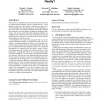Free Online Productivity Tools
i2Speak
i2Symbol
i2OCR
iTex2Img
iWeb2Print
iWeb2Shot
i2Type
iPdf2Split
iPdf2Merge
i2Bopomofo
i2Arabic
i2Style
i2Image
i2PDF
iLatex2Rtf
Sci2ools
SIGMOD
2008
ACM
2008
ACM
Column-stores vs. row-stores: how different are they really?
There has been a significant amount of excitement and recent work on column-oriented database systems ("column-stores"). These database systems have been shown to perform more than an order of magnitude better than traditional row-oriented database systems ("row-stores") on analytical workloads such as those found in data warehouses, decision support, and business intelligence applications. The elevator pitch behind this performance difference is straightforward: column-stores are more I/O efficient for read-only queries since they only have to read from disk (or from memory) those attributes accessed by a query. This simplistic view leads to the assumption that one can obtain the performance benefits of a column-store using a row-store: either by vertically partitioning the schema, or by indexing every column so that columns can be accessed independently. In this paper, we demonstrate that this assumption is false. We compare the performance of a commercial row-st...
Column-oriented Database Systems | Column-oriented Query Execution | Database | Query Executor Level | SIGMOD 2008 |
| Added | 08 Dec 2009 |
| Updated | 08 Dec 2009 |
| Type | Conference |
| Year | 2008 |
| Where | SIGMOD |
| Authors | Daniel J. Abadi, Samuel Madden, Nabil Hachem |
Comments (0)

